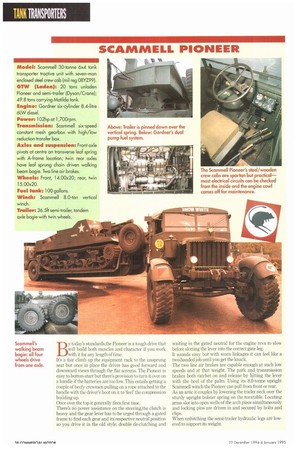SCAMMELL PIONEER
Page 40

If you've noticed an error in this article please click here to report it so we can fix it.
By today's standards,the Pioneer is a tough drive that will build both muscles and character if you work with it for any length of time. It's a fair climb up the equipment rack to the unsprung seat but once in place the driver has good forward and downward views through the flat screens. The Pioneer is easy to button-start but there's provision to turn it over on a handle if the batteries are too low. This entails getting a couple of beefy crewmen pulling on a rope attached to the handle with the driver's boot on it to leer the compression building up.
Once over the top it generally fires first time.
There's no power assistance on the steering,the clutch is heavy and the gear lever has to be urged through a gated frame to find each gear and its respective neutral position so you drive it in the old style: double de-clutching and waiting in the gated neutral for the engine revs to slow before slotting the lever into the correct gate-leg.
It sounds easy but with worn linkages it can feel like a two-handed job until you get the knack.
The two line air brakes are capable enough at such low speeds and at that weight. The park and transmission brakes both ratchet on and release by hitting the lever with the heel of the palm. Using its 8.0-tonne upright Scammell winch the Pioneer can pull from front or rear. As an attic it couples by lowering the trailer neck over the sturdy upright bolster spring on the turntable. Locating arms slot into open wells of the arch piece simultaneously and locking pins are driven in and secured by bolts and clips.
When unhitching the semi-trailer hydraulic legs are lowered to support its weight.




















































































































